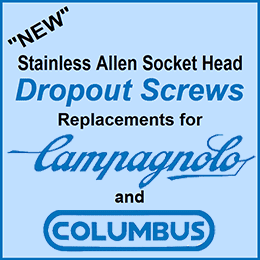Mike Moulton: Restored
 Fri, January 25, 2013
Fri, January 25, 2013

Somewhere back around the end of 2005 I received an email from a Joe Cerone:
Sir: I have a bike that was custom made for me by a Lockheed Engineer by the name of Mike Moulton, his name is stamped on the fork.
He made this for me in 1949 and I raced it all over America as well as a member of the All American Team that toured Japan in 1951.
I won three California State Championships on the bike, 49,50, 51. Are you any kin to Mike?----Joe Cirone.
This was the first I had heard of Mike Moulton. We are not related but Moulton is a quite common English name. I later wrote an article here, and as a result I was contacted by Mike Moulton’s daughter and his nephew, unfortunately after I responded they never got back to me.

As Joe stated, Mike Moulton was an engineer at Lockheed Aircraft and started building frames as a hobby around 1947.
He built frames for about 4 years or so. The bike on the left is the one he built for Joe Cerone.
Los Angeles area cyclists raced on his bikes all around especially in those early years when the Burbank track was up and running around 1948/9.
Just this week I received an email from Jeff Groman who sent me pictures of a beautifully restored bike built by Mike Moulton in the mid to late 1940s. It was originally built for a rider named “Rusty” Baker.

The bike is built up with period correct parts including Airlite hubs, Chater Lea cranks, the handlebar stem is of unknown make. The bike will be displayed at Classic Cycles, Bainbridge Island, WA.



Although Mike Moulton only built a few frames as a hobby, he did so in an era when there were very few other American framebuilders. So this is a wonderful thing that Jeff Groman has done by restoring this bike. It is an important piece of Americana and American bike history.
Mike would have had to get his materials mailed over from England. The lugs are Chater Lea cast steel. These were rough sand casting that required a great deal of hand filing, and were typical of those used by English builders in the 1930s and 1940s. The tubing is most likely Reynolds 531.
Below are pictures of the bike before restoration.
 Dave Moulton | Comments Off |
Dave Moulton | Comments Off | 





















Reader Comments (14)
What a nice restoration job! Thanks. By the way, what are the estimated costs of a project like this?
Jack,
Ay least $700 to $1,000. And I'm just guessing. More if there was re-chroming involved,
Dave
Dave,
It looks like the original rims were wood. Did Mr. Groman mention why the rims weren't restored?
In response to the question why we didn't restore the wood wheels. The bike was found with a mix of parts as most bikes that were raced are. Mike would use the best parts from the era. Paramount and British makes like Chater Lea, Airlite, Walton and Brown were available. The photo with the wood wheel set shows the bike with wheels it didn't come with to get an idea of the lines of the bike. Alloy wheels were in wide use in the period and riders used both types. While restoring the bike we looked at it with both types of wheels we opted for the aluminum as Mike was an aircraft guy and aircraft guys love aluminum. For its day this bike has incredible beautiful lines with a tight wheelbase and perfect frame angles. I would venture to say it was ahead of its time. Jeff
I would have to agree with Jeff that aluminum rims are actually period correct. I can only speak for what happened in England, but because of WWII there were huge strides made in aluminum alloys so in the mid to late 1940s wood rims would have been considered “Old Tech.” The only time I saw them used was for Grass Track racing, which was popular in the UK into the 1950s.
Also I agree this bike was ahead of its time, with the tight clearances, etc. A typical British track bike for that period would have mudguard (Fender.) eyelets and clearances. It would be an all purpose bike with a fixed wheel that its owner would ride to work on, take the mudguards off and ride a time-trial or grass track at the week end. Even put a saddle-bag on it and go touring.
Dave
What a neat bike! Thank you for sharing this. The seat tube angle looks very shallow (70 deg?), particularly for a track bike. I wonder if that was typical for bikes of this era?
Tom,
Yes, 70 degree seat angle would have been normal in the 1940s. I wrote about it here http://davesbikeblog.squarespace.com/blog/2009/6/5/old-bike-designs-die-hard.html
Track bikes sometimes had a seatpost shaped like a number "7" so the saddle could be adjusted forward. Or they were sometimes set forward as this one is, then used a support that went down to the top tube.
Dave
I have to plug Classic cycles , if you are in the area . Jeff has a great collection . Visit
The bike looks very much like the one I rode for everything, Track, grass racing road TT, hill climbs, cyclo cross club rides, etc as Dave has said we could only afford ONE frame. then we used what ever kit we needed for it. angles 73x71 or 72x72 the norm but it would in ENGLAND (of course this was a Yank bike), in Brit land we would have had mudguard loops, as you know it tends to rain a bit over there, Anyone that is inerested further in this, go to the classlightweights web site, read the stories of the clubmen in the reminis pages, see the bikes they rode,
Of all the componants of a track bike, I like the bars the best! The overall simplicity is wonderful. Nice bike and great restoration!
I am curious as to why there is an extension on the headtube. It was on the bike before restoration. Is this because sufficiently long handlebars quills were not made? All in all, a lovely job.
This bike was equip with a HEAD CLIP that had NO expander bolt,. I assume this is what you are talking about. You adjusted the height of the stem and the angle of the bars then tighten the bolt at the back of the head clip.this would also tighten the head bearing races. Even into the 1960s Hetchins and some other makers used the head clip I have one on my 1954 Hetchins. Modern bikes now have a very similar type fitting
Aha, thanks. I've only seen this set up one other time, but the cyclist passed me going far to fast for me to get a good look at exactly what it was.
Well, I'm getting back to you now. Sorry for the lapse in time. Last night on the Oscars I saw a nominee for Best Short or something like that and the title of one of the nominees was "Me and My Moulton". It is about a bicycle and it made me think of you. It didn't win, sadly. I love the pictures of my Dad's bike you restored. My Dad was a very talented man. He could build anything and make anything. His talent at the end of his life was painting, oils, acrylics, and watercolors. Like I said, he could do anything. He built golf clubs, he made his own fishing rods and tied his own flies. He had an Austin Healey where he made all components in stainless steel that could be made. Wonder where that car is today. Hope you still have his bicycle. If you ever want to get rid of it, I would love to have it back.